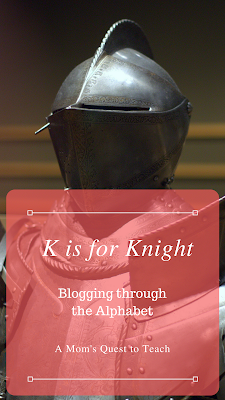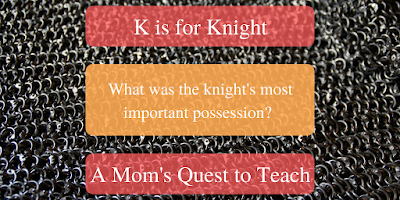This post contains affiliate links. For more information please see my Terms of Use and Disclosure Policy page. Thank you.
What images come to mind when you hear the word "Knight"? Do you immediately think of King Arthur and the Knights of the Round Table? Or perhaps A Knight's Tale – with its music and action – comes to mind? Knights were seen as an elite warrior class that evolved during the Middle Ages. They were sung about by troubadours, written about by poets, and remembered even in the movies of today.
Typically, the "Age of Chivalry" is the four centuries between 1100-1500 but there really isn't anything typical about the time. There was great variation in fighting methods and armaments.
Between the years 1325 and 1380, there was a change from chain mail to polished steel plate armor due to a number of changes in fighting. Two new weapons – the longbow and the great axe – grew in use, necessitating the change in armor.
"What is the function of knights? To guard the church, to fight unbelievers, to venerate the priesthood, to protect the poor from injuries, to pour out their blood for their brothers...and if need be, to lay down their lives." John of Salisbury, Policraticus, 1159 as quoted in Warrior: A Visual History of the Fighting Man
What identifies a knight?
- Special ceremonies
- Heraldic emblems decorating banners, shields, and surcoats
- Hereditary status
- Armor made of chain and later plate
- Process through which one becomes a knight
- Chivalrous attitude
- Horse
- Participating in tournaments
- Lance, sword, and shield
Knights were trained to be chivalrous – upholding moral standards and loyalty to one's leader and brothers-in-arms. Christian values were also emphasized: knights were supposed to respect and aid the needy and the poor when possible. When fighting battles and facing defeat, knights could surrender and not face death. As higher ranking members of society, a knight who surrendered could be ransomed by the winning side.
Not all knights were wealthy as some sought to better themselves in tournaments or on the battlefield with a military career. Others joined religious orders while still others might be hired during times of disorder and chaos. Knights were not always the most honorable.
Tournaments
Since there weren't always wars going on – I know, shocking, right? – knights needed to hone their skills and support themselves. So, they participated in tournaments. These events would not only provide entertainment for the public (can you hear the crowd cheering?) but also allow the knights to seek fame and fortune as they won jousting tilts.
There were several different ways knights participated in tournaments:
- Melee – mock battle that often devolved into a free-for-all
- Jousting
- Sword Fighting
Even though tournaments were not battles, life and death was still at stake. For example, in 1241 at the tournament at Neuss, there were over 60 knights killed. Eventually due to injury, death, and destruction of land where the tournaments were held, there would be strict rules put into place and the introduction of blunt weapons to be used. Rules were also introduced that stated what part of a knight or his horse an opponent could hit during the tournament in an attempt to make things safer.
The Longbow
One of the greatest changes came with the advent of the Welsh longbow. This allowed arrows to be fired that could pierce the chain mail armor of the best protected knight. The English used the longbow en masse to fire volleys of arrows – hundreds at a time – towards the enemy. They could fire 500 arrows and then 12 seconds later another 500 arrows would be launched towards the enemy. The English longbowman could fire arrows until they ran out of them. Usually he was equipped with 60 arrows stuffed into his belt or at his feet for easy access.
Along with the longbowman, there were other men with whom knights had to contend on the battlefield like pikemen and foot soldiers. During the Middle Ages, there were only about 200 knights participating in the battles but they are probably the most remembered.
There were 3 basic types of warriors in the 1100s:
- Men-at-arms – could include heavy cavalry and those fighting with a lance and sword
- Professional infantry
- Crossbowmen
Warfare Changes – The Hundred Years' War
During the Hundred Years' War, the true impact of the longbow was felt on the continent. At the battle of Crecy, the first true impression outside of England was seen by the French. The French would no longer be charging into battle on horseback.
Why was the Hundred Years' War fought? What were they like?
o In
1328, the last male member of France ’s
Capetian Dynasty died. King Edward III of England claimed the French throne.
o French
assembly choose Philip VI – Count of Flanders – as king.
o In
1337, Edward brought an army to Flanders.
o War
continued 116 years as a series of raids & battles. Sometimes there were long periods
of uneasy peace.
o England won many battles but lost the war. By
1453, France controlled all
of England ’s French lands
except Calais.
o New
weapons
o English foot soldiers
used longbows – one could fire arrows quickly – hitting targets up to 200 yards
away.
o Both the French and the English used gunpowder & cannons in battle
o Castles
no longer provided protection for a feudal lord b/c one powerful cannon could
break through a castle’s walls
o Knightly
warfare weakened
 |
| Click here to download your own vocabulary worksheet! |
There is so much to study when it comes to knights. If you wish to find out more information, I have provided some resources for you to read at your leisure.
I will also have a review on Home School in the Woods' Knights Lap-Pack at the end of July. Our five-year-old son and I are having a fun time working on projects relating to all things knight!









This was so cool to read! I am a genealogy buff and I have done extensive research on my great grandmother's family in England and I have quite a few ancestors who were knights...so I loved reading this info!!
ReplyDeleteVery cool! How neat to have knights in the family.
DeleteThis is great information! My boys would love to learn about knights as a Unit Study!
ReplyDeleteThere is so much exciting stuff to include when studying knights - from weapons and armor to castles and manors. Thank you for stopping by.
DeleteThis was a very informative read! And well put together!
ReplyDeleteThank you!
DeleteAlways interesting to read the information you share and how you put it all together. Thanks!
ReplyDeleteThank you! I love being able to share my love of history.
Delete